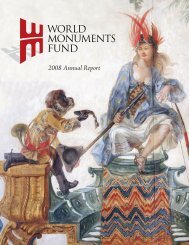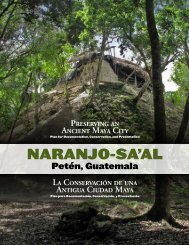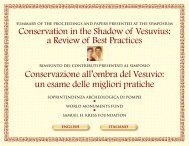Purana Qila and its surroundings (pdf) - World Monuments Fund
Purana Qila and its surroundings (pdf) - World Monuments Fund
Purana Qila and its surroundings (pdf) - World Monuments Fund
You also want an ePaper? Increase the reach of your titles
YUMPU automatically turns print PDFs into web optimized ePapers that Google loves.
© The British Library Board. (Add.Or.4825)<br />
1. <strong>Purana</strong> <strong>Qila</strong><br />
The second Mughal emperor, Humayun, probably had the least<br />
stable reign. As a result of his ongoing feud with with Sher<br />
Shah, Humayun ended up being ruler of Delhi for not very long.<br />
However, he managed to build a city known as Dinpanah (‘asylum<br />
of the faith’) on the site of the ancient Indraprastha (supposedly<br />
the capital of the P<strong>and</strong>avas around 1450 bc; excavations at the<br />
site have revealed signs of human habitation dating back to 300-<br />
200 bc, when the Maurya empire held sway). Work on Dinpanah<br />
began in 1530 <strong>and</strong> carried on till 1538; two years later, in 1540,<br />
Sher Shah Sur defeated Humayun <strong>and</strong> appropriated Dinpanah. In<br />
the five short years that Sher Shah ruled Delhi, he made substantial<br />
additions to the city, including the striking <strong>Qila</strong>-e-Kohna mosque<br />
<strong>and</strong> the octagonal tower known as Sher M<strong>and</strong>al. Sher Shah built<br />
his own city too, which he named Dilli Sher Shahi or Sher Garh.<br />
Fifteen years after he had been forced out, Humayun was back<br />
in Delhi, having defeated the Surs at Panipat. He embarked on a<br />
round of renovations at Dinpanah, which lasted only about a year,<br />
till his death in 1556.<br />
Today, Dinpanah is known as <strong>Purana</strong> <strong>Qila</strong> (also sometimes<br />
referred to as P<strong>and</strong>avon ka <strong>Qila</strong> – ‘the fort of the P<strong>and</strong>avas’), an<br />
oblong octagonal fort <strong>and</strong> an important l<strong>and</strong>mark of Delhi. The<br />
rubble <strong>and</strong> dressed stone walls of the fort complete a circuit over<br />
a mile long, pierced by three impressive gates: the Bada Darwaza,<br />
the Talaaqi Darwaza, <strong>and</strong> the Humayun Darwaza (also known<br />
as the South Gate). The walls themselves are as high as 20m in<br />
places, <strong>and</strong> approximately 4m thick.<br />
Timings: Sunrise – Sunset, Open daily. Tickets: Indian Citizens – Rs. 5.00, Foreigners<br />
– Rs. 100.00, Museum – Rs. 2.00. Amenities: wheelchair access, parking, small<br />
canteen inside fort.<br />
purana qila booklet.indd 3 27/09/12 3:37 PM
















